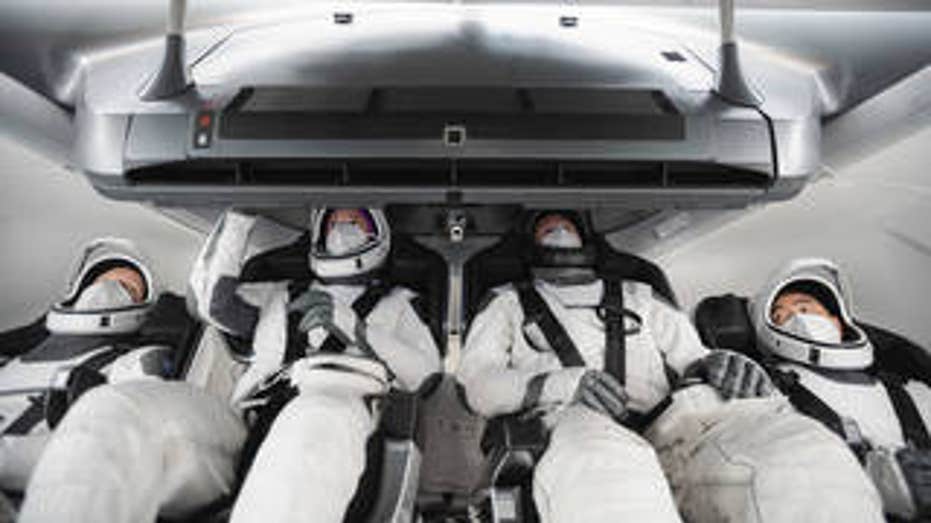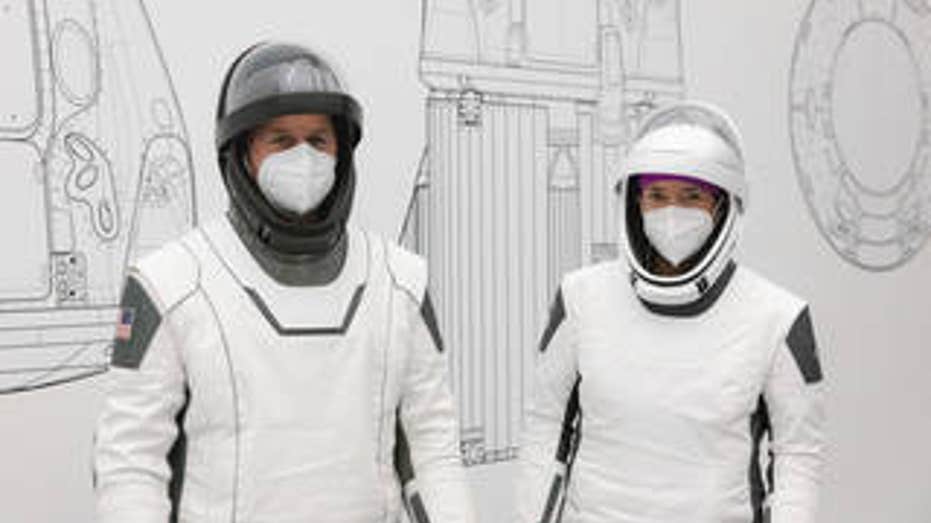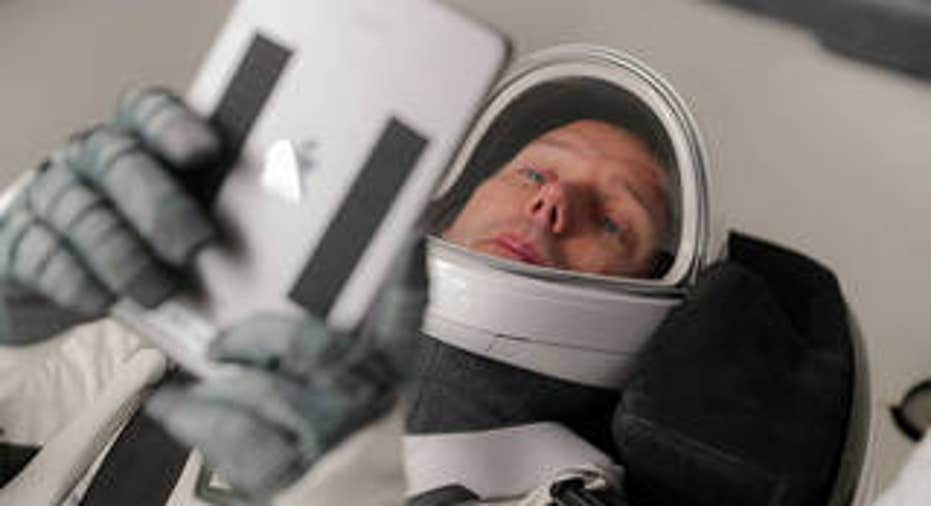NASA, SpaceX to launch second crew rotation mission to International Space Station
Crew-2 astronauts will spend approximately six months aboard the station
NASA is preparing for its SpaceX Crew-2 mission, which will lift off from Launch Complex 39A at Kennedy Space Center in Florida no earlier than April 20.
SpaceX Crew-2's four astronauts will fly aboard the aerospace company's Crew Dragon capsule on top of a Falcon 9 rocket. The mission marks the first time in over 20 years that astronauts from NASA, the European Space Agency and Japan Aerospace Exploration Agency have flown together.

The crew for the second operational SpaceX Crew Dragon mission, SpaceX Crew-2, trains inside a mockup of the vehicle at the SpaceX training facility in Hawthorne, California. From left are, Mission Specialist Thomas Pesquet of the European Space Agen (SpaceX)
The astronauts of Crew 2 will be welcomed aboard the International Space Station by the Expedition 65 crew, including the Crew-1 astronauts who currently remain onboard. In total, the ISS will have a crew size of seven people.
ORBITAL ASSEMBLY CORP. HITS $1M FUNDRAISING GOAL, AIMS TO HAVE LUXURY SPACE HOTEL OPEN IN 2027
Crew Dragon will accelerate its passengers to approximately 17,500 mph and put it on an intercept course with the International Space Station. The Falcon 9 used to launch the mission is using the same booster as NASA's SpaceX Crew-1, marking the first time a flight-proven booster will be used for a crewed launch.
Once in orbit, the crew and SpaceX mission control will monitor a series of automatic manuevers that will guide the crew to the International Space Station. Following a predetermined period in orbit, the Crew Dragon capsule will dock autonomously onto the station.
The Crew-2 astronauts will spend approximately six months aboard the station, conducting scientific research in areas such as medical technology, human health, and materials to benefit life on Earth, before returning in fall 2021.
During their stay on the orbiting laboratory, astronauts of Crew-2 will see cargo spacecraft, including the Northrop Grumman Cygnus and the SpaceX cargo Dragon and conduct a series of spacewalks to install new solar arrays, increasing the station’s total available power from 160 kilowatts to up to 215 kilowatts. The crew will also test the Butterfly IQ Ultrasound, a portable ultrasound device used in conjunction with a mobile computing device in the space environment.
In addition, they will conduct a variety of tissue engineering investigations, ranging from studies of bone, cardiovascular, muscle and liver health. An experiment from retail store Target will study cotton growth in microgravity to help identify more robust cotton varieties that require less water and pesticide use.
VIRGIN GALACTIC DELAYS SPACEFLIGHT TEST TO MAY
SpaceX Crew 2's commander, Shane Kimbrough, will be responsible for all phases of flight, from launch to reentry. He also will serve as an Expedition 65 flight engineer aboard the station. Kimbrough, a retired U.S. Army colonel, first launched aboard space shuttle Endeavour for a visit to the station on the STS-126 mission in 2008, then aboard a Russian Soyuz spacecraft for Expedition 49/50 in 2016. He has spent a total of 189 days in space, and performed six spacewalks.
During a news conference on Monday, Kimbrough outlined the intense training that the crew has been going through in preparation for the mission over the past year.
"You're doing a lot of academic classes, learning all their systems, and then you progress into the simulator where you're just doing the kind of simulations with just you and your crewmates or maybe just in our case, Megan and I as pilot and commander. And then eventually you'll get into the simulation campaign with the mission control teams from SpaceX and NASA. And that's where we're kind of in that phase right now, then kind of ramping that up with only a couple more weeks of that to go before we're ready to fly in space."

NASA astronauts (from left) Shane Kimbrough and Megan McArthur, commander and pilot respectively for the SpaceX Crew-2 mission to the International Space Station, pose for a portrait during a training session at the SpaceX training facility in Hawtho (SpaceX)
SpaceX Crew-2's pilot, Megan McArthur, will be responsible for the spacecraft systems and performance. The mission will be McArthur's first trip to the International Space Station. In 2009, McArthur launched on space shuttle Atlantis as a mission specialist on STS-125, the final Hubble Space Telescope servicing mission. She operated the shuttle’s robotic arm over the course of the 12 days, 21 hours she spent in space, capturing the telescope and moving crew members during the five spacewalks needed to repair and upgrade it.
McArthur said at Monday's press conference that the most intense part of astronaut training has been "the volume and variety of the things that we have to cram into our brains before we get ready to launch."
"We're not only learning a brand new vehicle that we're going to launch in and how to monitor and operate in that vehicle, but we're also learning all of the things that we're going to be expected to do while living aboard the space station," she said. "And so that's not only caring for the space station, but it's also conducting a variety of different science experiments."
GET FOX BUSINESS ON THE GO BY CLICKING HERE
Rounding out the crew are mission specialists Akihiko Hoshide and Thomas Pesquet, who will work closesly with Kimbrough and McArthur to monitor the spacecraft during the launch and reentry phases of flight. Hoshide will also serve as a flight engineer for Expedition 65 and Pesquet will become a long-duration crew member aboard the space station.
JAXA (Japan Aerospace Exploration Agency) astronaut Akihiko Hoshide, mission specialist for the SpaceX Crew-2 mission to the International Space Station, trains inside a mockup of the SpaceX Crew Dragon vehicle during a training session at the SpaceX training facility in Hawthorne, California. (SpaceX)
Hoshide, a veteran of two space flights, joined the National Space Development Agency of Japan (NASDA, currently JAXA) in 1992 and was selected as an astronaut candidate in February 1999. In June 2008, he flew to the International Space Station on the STS-124 mission to deliver the Japanese Experiment Module "Kibo." From July to November 2012, he stayed on the space station for 124 days as a flight engineer for the Expedition 32/33 mission. The Crew Dragon will be the third spacecraft that Hoshide has flown to the orbiting laboratory.
Hoshide said during Monday's press conference that he's most excited to fly on the new Crew Dragon and compare "the differences and similarities" with other spacecraft he's flown on.
Pesquet was selected as an astronaut candidate by the European Space Agency in May 2009 and worked as a Eurocom, communicating with astronauts during spaceflights from the mission control center. He previously flew as part of Expeditions 50 and 51, launching aboard a Russian Soyuz spacecraft and spending 196 days in space. His mission also included two spacewalks to maintain the station: one to replace batteries on an electrical channel, and one to fix a cooling leak and service the robotic arm.
Pesquet offered his advice to individuals aspiring to become astronauts with the ESA.
"You need to be to have some academic background because we're living in a technical, scientific environment. You need to have some operational experience because you're also in a dangerous environment and your decisions have consequences and you need to be international," he said. "With the European Space Agency, we speak all languages and look at us with the Japanese, American, Russians and tomorrow maybe other nationalities on board the space station."
CLICK HERE TO READ MORE ON FOX BUSINESS
The crew hopes that the mission will inspire others to want to become astronauts.
"We're going to do our very best to represent NASA and ESA, JAXA and SpaceX and the International Space Station and hopefully by just our actions and the way where we're professional, the way we had a good time as well, that that'll just translate into some kind of inspiration for somebody," Kimbrough said.
Pesquet added that having McArthur as the mission's pilot will specifically inspire young women.
"We're trying to reach 50%, you know, in any application selection for the national selection," Pesquet said. "This is difficult, but I think that the fact that we have Megan is certainly helping the cause and I'm hoping next astronaut selection for you is going to be 50% male, 50% women, hopefully."
The Crew Dragon capsule, dubbed "Endeavour," is the same spacecraft used by astronauts Douglas Hurley and Robert Behnken during their historic Demo-2 mission. It will remain docked for the full duration of the mission before autonomously undocking with the four astronauts on board and heading back into Earth's atmosphere.
After splashdown just off Florida’s coast, a SpaceX recovery vessel will pick up the crew and bring them back to shore to board a plane for return to NASA’s Johnson Space Center in Houston.






















